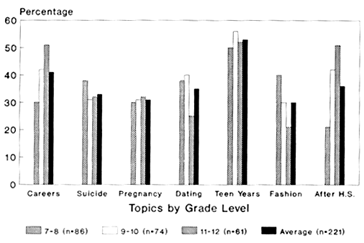Spring 1991 // Volume 29 // Number 1 // Feature Articles // 1FEA8
Give Teens the Programs They Want...and Need
Abstract
Designing programs to meet "felt needs" of clientele is definitely the key to maintaining involvement and may help keep youth at risk from leaving 4-H. The 4-H Senior Needs Assessment has been a valuable tool in identifying teen interests and felt needs, the first step in targeting these youth for Extension's national Youth-at-Risk Initiative.
Louisiana 4-H, as in some other states, has been faced with declining enrollment of youth ages 13 and over. Many teens seem to lose interest in school and extracurricular programs that have held their attention in the past. Is this because programs in 4-H are seen to be "old-fashioned" or "not cool" by modern teenagers?
One rural parish has proven again the value of building programs around "felt needs." They've increased 4-H enrollment and retained teen members by designing their program around ideas that teens themselves indicated were of interest to them. In Iberville Parish, a Senior Needs Assessment was conducted annually for three years to determine the "felt needs" of 4-H teens. Items on the survey came from a "Youth Statistics" packet produced from a study done in Texas1 and from personal observations made by the 4-H Advisory Committee. Terms used were a combination of traditional topics covered in 4-H programs and concepts now common in current jargon.
Surveying Teens
4-Hers in seventh through 12th grades were asked to indicate the five topics they'd most like to have additional information about and those they did not want to know anything else about. Results of the most recent survey made of 221 teenagers are in Figure 1. The figure shows the seven topics of highest interest by grade level.

Figure 1. Topics of highest interest.
As may be expected, some topics of interest to the teens varied substantially by grade. As grade level increased, students showed more concern with jobs, careers, and options after high school. Seventh and eighth graders were more interested in fashion than were ninth through 12th graders. Juniors and seniors were less concerned about dating than were the younger students. Teen pregnancy and teen suicide were of interest across all grades. This may have been due in part to three recently attempted suicides at a junior high school where 4-Hers were involved in this study.
The topic of the emotional, physical, and psychological adjustments of the teen years received substantial interest ratings across all grade levels, with at least 50% of each group listing it among the top five areas of interest.
In Table 1, topics rated of only some interest are listed, while Table 2 shows the topics of no interest.
| Fitness
Drugs and alcohol Parent-teen communication Public speaking Leadership Independent living Money management Computers Peer pressure Decision-making skills |
Table 2. No interest.
|
Stress management Nutrition Study skills Safety Health Communication Time management Grooming Family breakups Unemployment Consumerism Goal setting Citizenship First aid |
Lessons Learned
Several interesting conclusions can be drawn from the survey results:
- Topics that have been the mainstays of 4-H programming for years-health, safety, nutrition, and consumerism-are no longer of primary interest to teens.
- Although interest in teen suicide, pregnancy, and the teen years is of major interest, stress management is not. Surely these situations are causing stress in teens, but they may not understand the term or recognize stress as it manifests itself in their lives.
- Jobs and careers and what to do after high school are of primary interest to older teens, yet no interest exists in goal setting. Introducing concepts such as career ladders or life planning may establish the idea of goal setting from another perspective and show how it relates to one's future.
- Adults can attest to the importance of many topics not considered of interest by these teens. Creative educators can design ways to integrate these concepts into areas of expressed concern to youth.
- Titles assigned to concepts may be turning off some teens. For example, teens in this survey wanted no more information on nutrition and health, yet were less adamant about not receiving information on fitness, a more "current" concept. They didn't want information on grooming, yet 31% wanted fashion information. Educators may need to browse through magazines for young audiences, watch television shows they see, observe advertisements and places where they shop, listen to their music, or simply listen to them talk to learn what terms they use.
Redesigning Extension Programs
Based on survey results over the past three years, the program for teenage 4-H members in this rural Louisiana parish has been redesigned to appeal to the modern teenager by addressing topics they say are of interest to them. The survey has accomplished its original purpose. Over the past two years, enrollment reports indicate a 21% increase in the senior 4-H retention rate!
Designing programs to meet "felt needs" of clientele is definitely the key to maintaining involvement and may help keep youth at risk from leaving 4-H. The 4-H Senior Needs Assessment has been a valuable tool in identifying teen interests and felt needs, the first step in targeting these youth for Extension's national Youth-at-Risk Initiative.
Footnote
1. Texas Agricultural Extension Service, "Youth Statistics" (College Station: Texas A&M, 1986).
